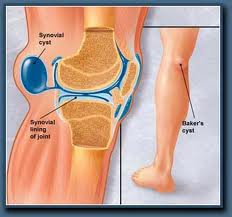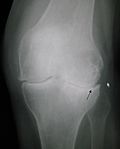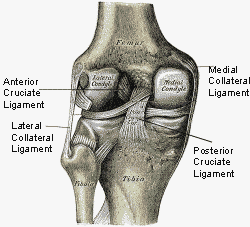Pain Behind the Knee
Pain behind the knee aka posterior knee pain can be due to a number of problems. Sometimes is develops gradually over time indicating and underlying problem with part of the knee. Othertimes, it develops suddenly due to an injury. Some people complain of a general achy back of knee pain, others find their leg movements may be restricted by swelling or there may be a sharp pain at the back of the knee.
Here we will look at the most common causes of pain behind the knee. By thinking about how your pain started, the common symptoms and how your pain behaves, you can work out what is causing your pain. As you read through each summary, you can decide whether it sounds like your problem or not. If it does, click on the link to find out more about treatment options and the recovery process. If it doesn't sound quite like your pain, simply move on to the next one.
Here we will look at the most common causes of pain behind the knee. By thinking about how your pain started, the common symptoms and how your pain behaves, you can work out what is causing your pain. As you read through each summary, you can decide whether it sounds like your problem or not. If it does, click on the link to find out more about treatment options and the recovery process. If it doesn't sound quite like your pain, simply move on to the next one.
1) Bakers Cyst
What is it: Inflammation of thepopliteal bursa (fluid filled sac) at the back of the knee. It is the most common cause of pain behind the knee.
Symptoms: Swelling (like a small water balloon), tightness and pain behind the knee
Aggravating Activities: Bending and straightening the knee, walking, kneeling
Onset: Can come on after a blow to the back of the knee but usually comes on gradually. Often associated with arthritis - fluid from the arthritis leaks back into the bursa causing it to swell
Treatment: Ice, exercises, aspiration, injection, electrotherapy and occasionally surgery
Recovery: Can take a few months for the pain behind knee to settle down and they have a tendancy to recur if not treated properly
Symptoms: Swelling (like a small water balloon), tightness and pain behind the knee
Aggravating Activities: Bending and straightening the knee, walking, kneeling
Onset: Can come on after a blow to the back of the knee but usually comes on gradually. Often associated with arthritis - fluid from the arthritis leaks back into the bursa causing it to swell
Treatment: Ice, exercises, aspiration, injection, electrotherapy and occasionally surgery
Recovery: Can take a few months for the pain behind knee to settle down and they have a tendancy to recur if not treated properly
Find out more: Bakers Cyst Knee
2) Posterior Cartilage/Meniscus Tear
What is it: Tear at the back of the cartilage lining the joint
Symptoms: Pain behind the knee, swelling, locking, instability, difficulty straightening the knee
Aggravating Activities: Walking, running, squatting, stairs esp going up
Onset: Can occur suddenly with a force through the knee, sudden twisting of the knee or gradually through wear and tear
Treatment: PRICE, exercises, tubigrip, knee brace and occasionally surgery
Recovery: Can take months to recover as the meniscus has a poor blood supply, which slows healing
Symptoms: Pain behind the knee, swelling, locking, instability, difficulty straightening the knee
Aggravating Activities: Walking, running, squatting, stairs esp going up
Onset: Can occur suddenly with a force through the knee, sudden twisting of the knee or gradually through wear and tear
Treatment: PRICE, exercises, tubigrip, knee brace and occasionally surgery
Recovery: Can take months to recover as the meniscus has a poor blood supply, which slows healing
Find out more: Meniscus Tears
3) Arthritis
What is it: Changes in the bone usually caused by wear and tear (osteoarthritis) or sometimes by inflammation (rheumatoid arthritis)
Symptoms: Morning stiffness, pain, swelling,clicking/grinding, reduced leg movements
Aggravating Activities: Worse after prolonged rest, activity, cold weather
Onset: Symptoms gradually come on over time. Most common over the age of 50
Treatment: Exercises, knee brace, heat, ice, acupuncture, weight loss, walking aids, gel knee pads, cushioned footwear, medication, injections
Recovery: The changes in the bone from arthritis cannot be undone, buttreatment aims to reduce pain, improve function and prevent deterioration
Symptoms: Morning stiffness, pain, swelling,clicking/grinding, reduced leg movements
Aggravating Activities: Worse after prolonged rest, activity, cold weather
Onset: Symptoms gradually come on over time. Most common over the age of 50
Treatment: Exercises, knee brace, heat, ice, acupuncture, weight loss, walking aids, gel knee pads, cushioned footwear, medication, injections
Recovery: The changes in the bone from arthritis cannot be undone, buttreatment aims to reduce pain, improve function and prevent deterioration
Find out more: Arthritis
4) Hamstring Injury
What is it: A tear in one of the hamstring muscles on the back of the thigh
Symptoms: General achy pain in back of knee where hamstring tendon attaches to the bone. Sharp pain behind knee with sudden movements
Aggravating Activities: Bending the leg, sudden acceleration or deceleration when moving.
Onset: Sudden onset with an injury
Treatment: PRICE, exercises, massage, tubigrip
Recovery: Usually takes 6-12 weeks to fully recover
Symptoms: General achy pain in back of knee where hamstring tendon attaches to the bone. Sharp pain behind knee with sudden movements
Aggravating Activities: Bending the leg, sudden acceleration or deceleration when moving.
Onset: Sudden onset with an injury
Treatment: PRICE, exercises, massage, tubigrip
Recovery: Usually takes 6-12 weeks to fully recover
5) Knee Sprain
What is it: Overstretching/tearing one of the ligaments in the knee
Symptoms: General pain, swelling, bruising, occasional giving way and/or decreased movement
Aggravating Activities: Depends on the severity but can be any physical activity or movement of the knee
Onset: Sudden twisting movements or a force through the knee
Treatment: PRICE, exercises,tubigrip, knee brace
Recovery: There are 3 grades of knee sprain depending on how much damage there is. It can take anything from 2 weeks to 3 months to fully recover, depending on the severity of the injury
Symptoms: General pain, swelling, bruising, occasional giving way and/or decreased movement
Aggravating Activities: Depends on the severity but can be any physical activity or movement of the knee
Onset: Sudden twisting movements or a force through the knee
Treatment: PRICE, exercises,tubigrip, knee brace
Recovery: There are 3 grades of knee sprain depending on how much damage there is. It can take anything from 2 weeks to 3 months to fully recover, depending on the severity of the injury
Find out more: Knee Sprains


